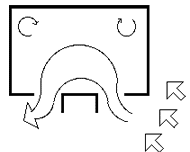Passive Cooling Techniques
The keys to passive cooling of a house are keeping the Sun out and moving cool air in. Stone, masonry, and concrete, the building materials best able to warm a building in the cold weather, can also keep cool air inside in hot weather. However, this means preventing as much direct sunlight as possible from reaching those walls and floors with thermal mass, so they do not retain heat. The way to do this is with shade, in the form of overhangs over the windows, to keep sunlight off the walls and windows during warm weather when the Sun is at a high angle. Shade can come from other sources as well. A line of deciduous trees—ones that lose their leaves in the winter—can provide shade to the equator side of the house during the hottest months.
 |
Photo courtesy of DOE/NREL, Robb Williamson Clerestory windows provide daylighting to the interior of buildings. These windows can also be opened to let out hot air that accumulates near the ceiling. |
||
|
|
|||
Ventilation provides air circulation, and it moves the cool air in at night. Casement or awning windows, which open on side or top hinges, can be installed to take advantage of the prevailing direction of the breezes of the location. Clerestory windows can be opened to let out the hot air at the top of the building.

Image courtesy of Bill Christensen, Greenbuilder.com The thermal chimney is used to create updrafts and remove heated air. It is built on the sunny side of the building. A black metal heat absorbing panel is used to create even more heated air that will naturally rise. This pulls the air up and out.
|
If there is little steady direction to the wind, wing walls can be built to control airflow in and out of windows. Solid wall panels built between the windows and perpendicular to the main wall can steer air coming in and out of a room.
A thermal chimney or a similar effect created with venting windows can also help to move out hot daytime air. The key is creating convective cooling. Cool air is pulled in from the ground and hot air is pushed out from a high point of the building. A vented sunroom, thermal chimney, or high windows on open stairwells can all accomplish this.
A builder can make use of the appropriate passive cooling and heating techniques to construct a house that uses very little energy.
This content has been re-published with permission from SEED. Copyright © 2025 Schlumberger Excellence in Education Development (SEED), Inc.


